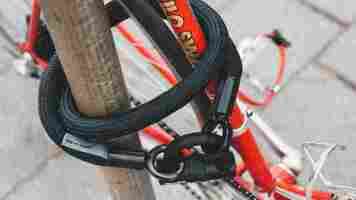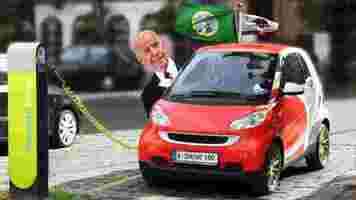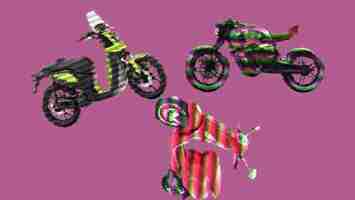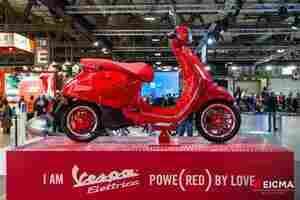How my stolen bike inspired an IoT innovation
This article was written by Pierre Regnier on The Urban Mobility Daily , the content site of the Urban Mobility Company, a Paris-based company which is moving the business of mobility forward through physical and virtual events and services. Join their community of 10K+ global mobility professionals by signing up for the Urban Mobility Weekly newsletter . Read the original article here and follow them on Linkedin and Twitter .

The Business of Mobility is an Urban Mobility Company series highlighting some of the most successful new businesses in the mobility sector. Featuring a closer look at the way in which companies stand out, CEOs, Directors and other c-level executives elaborate on what it takes to turn a great idea into a great company.
Pierre Regnier, CEO of Velco , explains how Velco is working with both operators and manufacturers to improve the functionality of micromobility and help clients build long-term relationships with end-users
In 2016 I was doing my internship in Paris. As transport was expensive, I was using my bike to get around. One day after leaving the office, I came outside to find my bike had been stolen. The sinking feeling of loss was replaced by inspiration when that night I watched a TV show about the invention of a connected wallet to prevent theft and loss.
I then got together with two friends from Audencia Business School (Johnny Smith and Romain Savouré) where we had been studying, and so began our quest to use IoT to improve the micromobility experience.
In 2019 we launched the Wink Bar, a handlebar for ebikes with telematics embedded. The Wink Bar boasted some unique innovations, like headlights that turn on automatically in the dark and a navigation system with flashing lights to tell riders when to turn left or right. Our experience in creating the Wink Bar exposed us to developments in the urban mobility industry, with data and connectivity becoming increasingly important.
We realized that we needed telematics not just for e-bikes but for escooters, emopeds and other micromobility. So, we introduced Onitrax (a small plug-in telematics device) mainly for e-scooters and emopeds and re-designed and rebranded the Wink Bar as Nuotrax. Our clients like the integrated design of Nuotrax, which also has the advantage of a quick and simple retrofit. Bike technicians are not having to fit telematics, with the complications of casing and electronics, they’re simply fitting a handlebar.
Single-car ownership is on the way out as cities encourage electric powered micromobility, which will improve traffic flow and reduce emissions. It’s therefore vital for mobility businesses to match the advantages of car ownership and encourage commuters to make the switch. IoT (the Internet of things) is what’s driving the new mobility revolution as MaaS (mobility-as-a-service) and SaaS (software-as-a-service) turn transport vehicles into platforms of ever-improving utility.
Our mission is to use telematics and SaaS to improve micromobility in three key areas: anti-theft, safety and maintenance. As Johnny Smith (our CMO) put it: “Our aim is to accompany clients by creating value from the data collected and transforming it into high value-added services for your company and users.” The functionality is virtually limitless, both for the operator and the end-user. Operators can track maintenance needs, user flows, average distance traveled, etc. Users can track CO2 savings, geolocate their bike, be warned of potential theft incidents, etc.
Our relationship with Véligo, the world’s largest long-term ebike rental company, has given us a valuable insight into how the industry is developing, with both operators and manufacturers wanting to build a long-term relationship with users. IoT has become a powerful tool for marketing and CRM (customer relationship management) purposes.
While our telematics for operators and manufacturers is the same, we differentiate on our SaaS offering: Velco Fleet for operators and Velco OEM for manufacturers. These are white label apps that can be modified to meet the client’s specific needs and are aimed at improving the customer experience.
Currently ebike manufacturers are struggling to keep up with consumer demand. This is one reason profit margins on e-bikes are relatively high compared to cars, but this will change as the market matures. Ebike manufacturers will emulate the automotive industry in their business model, exploring annuity revenue potential for servicing, maintenance, financing and added features that come with the connectivity and data-collection capabilities of telematics.
Customers want a hassle-free, safe and consistent ride. Given how much money an ebike can save them in car ownership and other transport costs, they’re willing to pay something for the service. Ebike manufacturers can embed IoT costs in the price of the bike for the first three years and then offer those services at a small monthly fee (e.g. 30 Euro) after that. These services can include proactive and predictive maintenance, battery replacement, anti-theft tracking, accident rescue, etc. The manufacturer can thus guarantee a seamless service, with minimal downtime. Customer features and functionalities will be added as the technology grows and improves.
No-one can be exactly sure where the Fourth Industrial Revolution is taking us. Just like no one predicted how smartphones would turn into platforms for independently designed apps, we cannot be sure how IoT will improve micromobility. It’s possible that in the next ten to fifteen years micromobility will become autonomous, with all devices and vehicles connected as a way of eliminating traffic accidents.
For now, we will continue to work with operators and manufacturers in laying the foundations of better, cleaner, mobility patterns.
Do EVs excite your electrons? Do ebikes get your wheels spinning? Do self-driving cars get you all charged up?
Then you need the weekly SHIFT newsletter in your life. Click here to sign up .
12 US states call for Biden to ban combustion cars from 2035
Get a load of this. America is finally coming down hard on combustion engine vehicles.

Governors of 12 US states are campaigning for President Biden to take a leaf out of California and Washington’s play book, and ban combustion engined cars by 2035.
The states campaigning for the move are: California, New York, Massachusetts, North Carolina, Connecticut, Hawaii, Maine, New Jersey, New Mexico, Oregon, Washington State, and Rhode Island.
As Reuters points out , even though Biden has committed $174 billion to incentivize the uptake of electric vehicles in the US, and build supporting infrastructure, his plans do all but ban fossil fuel-powered passenger cars.
In a letter to the President, seen by Reuters , governors are asking “to ensure that all new passenger cars and light-duty trucks sold are zero-emission no later than 2035 with significant milestones along the way to monitor progress.”
Earlier this month, Washington state took measures to effectively ban the sale of combustion engine cars from 2030 .
If all goes to plan, Washington will be the first US state to ban dinojuice drinking vehicles. Previously, California had that crown , and currently plans to ban combustion vehicles from 2035.
It seems America is finally coming around to the idea of electric vehicles, and it could join a host of European nations in banning ICE vehicles.
Sales of EVs for the first three months of the 2021 rocketed by 81% over the same period last year in the US. With supporting legislation, that trend will only continue.
Do EVs excite your electrons? Do ebikes get your wheels spinning? Do self-driving cars get you all charged up?
Then you need the weekly SHIFT newsletter in your life. Click here to sign up .
We picked the 3 coolest two-wheelers from the EIMCA Moto Show
This year’s EICMA Moto Show started on November 25 and, boy, has it showcased some juicy rides for two-wheeler lovers.

Sadly, I was unable to attend, but I could comfort myself with endless scrolling through the show’s official page. And while it was difficult to choose the coolest vehicles on display, these were three that really blew me away.


Yes, I know, Vespas are always iconic and beautiful. And yes, the electric Vespa was already introduced way back in January . But this one is… RED!!!
While the color might be the only new feature ‘spec-wise’ the Vespa Elettrica RED does come with and added dose of the feel goods.
Piaggio has teamed up with (RED), a non-profit organization that helps fight global pandemics such as HIV and AIDS. For every Vespa RED purchased, a $100 will go to supporting the organization’s mission.
Performance-wise, the Vespa RED shares the same characteristics with the original electric model. It comes with a 4.2kWh battery and has two top speed variants: 40km/h for inner-city rides and 70km/h, which can easily take it on a highway.
I also love its multimedia display that connects the vehicle with your smartphone.
Well, I wouldn’t call it a beauty per se… but it does undoubtedly possess the allure of tricked out gamer rigs. There’s just something about its aggressive futurism that I find weirdly striking.
Interestingly, it’s the first escooter vision from Fantic , which produces motorcycles and ebikes, and we can see that it’s kinda a mix of both.
Powered by a 3kWh electric motor, the model on display is a 50cc scooter, although the company is envisioning a 125cc version as well.
It’ll be equipped with a 2,200Wh lithium battery and will have with a second battery as well, which the Italian brand says will guaranty range of more than 100km.
The scooter can be operated via smartphone with a dedicated app and customized with various accessories, including high windshield, leg deflectors, leg cover, rear case, and side bags.
As for when it’ll reach production? We have no idea, but I’d like to see it in action soon.
This one’s my favorite by far.
Merging the retro vibes of a 1920s café with a souped up racing motorcycle, the NAWA racer is an absolute stunner. The bike also brings an intriguing modern twist, featuring the world’s first hybrid electric powertrain, as NAWA claims.
Simply put, the bike’s battery combines two different power sources: the conventional lithium-ion cells and nano-based ultracapacitors (i supercapacitors ), patented by the company as NAWACap .
According to NAWA, the combined tech has four impressive advantages: it improves efficiency, reduces the size of the battery and the charging time, doubles the range, and extends the system’s life.
Plus, the company says the technology is scalable and could be applied to EVs as well — which is something I’d really like to see.
Not a lot of the NAWA Racer’s specs have been disclosed, but the company has said its meant to have a whopping 300km range and a 62mph acceleration in under three seconds.
But here’s the sad news: the bike’s only a concept and NAWA doesn’t plan to build it itself. Instead, it’s seeking partners who are interested in making a production version (and probably who’ve got enough cash to get it off the ground).
Maybe it’s time I consider selling some organs.